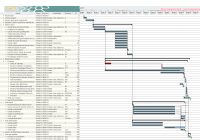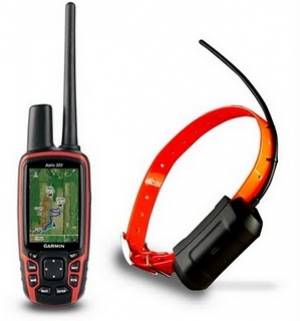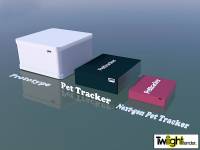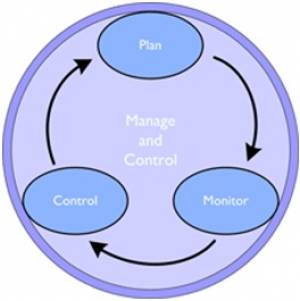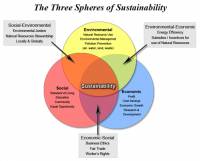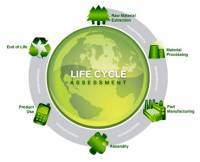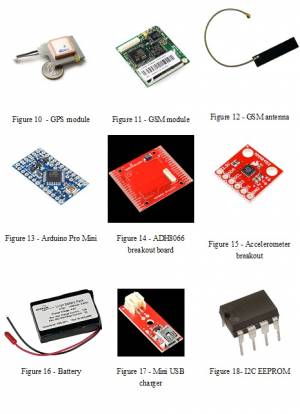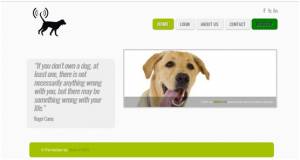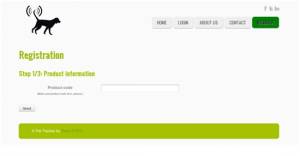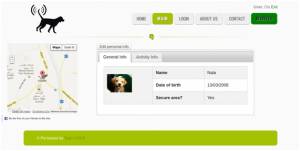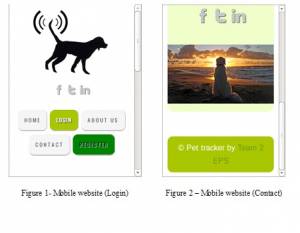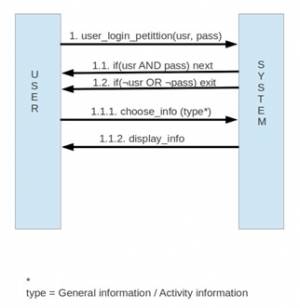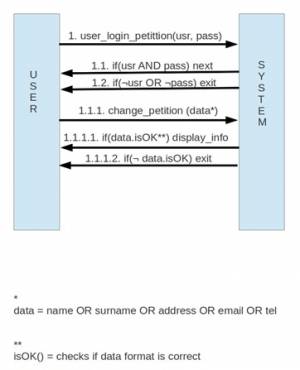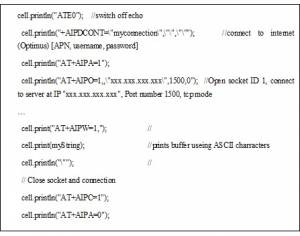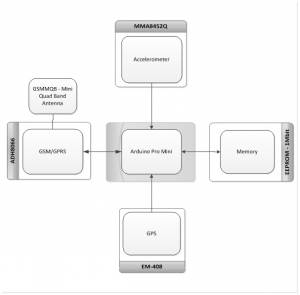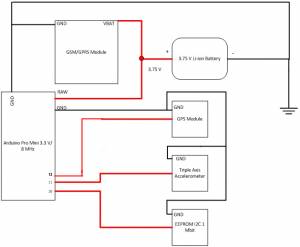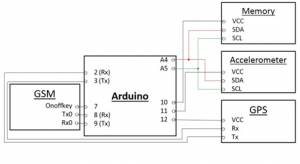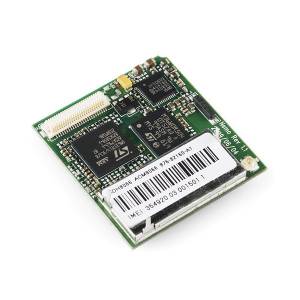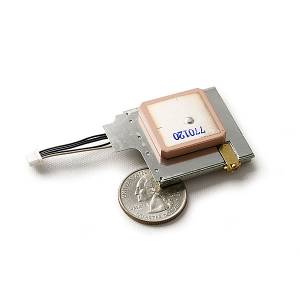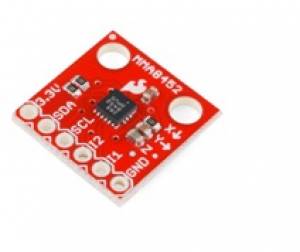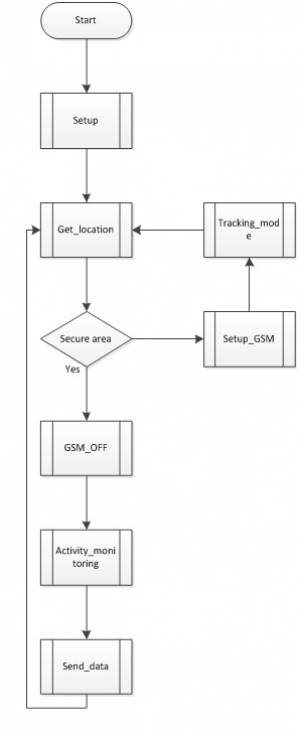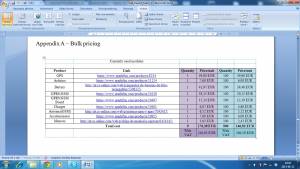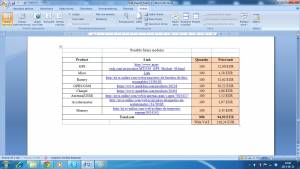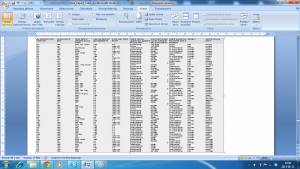Table of Contents
Report
“Work is the greatest thing in the world, so we should always save some of it for tomorrow.” Don Herold
Abstract
Ten million pets are lost every year [1]. A lot of these animals could have been found if they wore some kind of tracking device. We believe that our product is a solution to this common problem, and that it would reduce the number of lost animals.
We have analysed existing products and looked for opportunities to stand out among them. Most of the already existing products only provide tracking features. Therefore we decided to add extra features to stand out among others. This report describes the development process of a system for pets that monitors their activity besides being a tracking device
Glossary
API – Application Programming Interface
ASK – Amplitude Shift Keying
AT – Attention
CE – Conformité Européenne
CPU – Central Processing Unit
DSI – Display Serial Interface
EU – European Union
FSK – Frequency Shift Keying
GLONASS – Globalnaya Navigatsionnaya Sputnikovaya Sistema
GNSS – Global Navigation Satellite System
GPRS – General Packet Radio Service
GPS – Global Positioning System
GSM – Global System for Mobile Communications
HDMI – High Definition Multimedia Interface
I2C – Inter-Integrated Circuit
IEEE – Institute of Electrical and Electronics Engineers
Li-ion – Lithium ion
Li-Po – Lithium Polymer
MCU – Microcontroller unit
MySQL – My Search and Query Language
NiCd – Nickel–Cadmium
NiMH – Nickel–Metal Hydride xiv
NiOOH – Nickel Oxyhydroxide
NIST – Nation Institute of Standards and Technology
NiZn – Nickel-Zinc
NSPE – National Society of Professional Engineers
ODM – Original Design Manufacturer
OEM – Original Equipment Manufacturer
OOK – On/Off Keying
PCB – Printed Circuit Board
RADAR – Radio Detection And Ranging
RAM – Random Access Memory
RCA – Radio Corporation of America
RF – Radio Frequency
RISC – Reduced instruction set computing
ROHS – Restriction of Hazardous Substances
RWD – Responsive Web Design
SIM – Subscriber Identity Module
SRAM – Static Random Access Memory
SWOT – Strengths, Weaknesses, Opportunities, and Threats
USB – Universal Serial Bus
USD – United States Dollar
VAT – Value Added Tax
WIPO – World Intellectual Property Organization
USD - United States Dollar
List of Tables
Table 1 - Team members
Table 2 - Table of tasks
Table 3 - GSM/GPRS network ranged trackers[3]
Table 4 - RF ranged trackers[3]
Table 5 - Wireless technologies comparison
Table 6 - Location system comparison
Table 7 - Single board microcontroller comparison
Table 8 - Battery comparison
Table 9 - SWOT analysis
Table 10 - Marketing expense budget
Table 11 - Material list
Table 12 - Power consumption with regular use
Table 13 - Power consumption in tracking mode
List of Figures
Figure 1 - Gantt chart
Figure 2 - Maslow's hierarchy of needs
Figure 3 - Garmin Astro [27]
Figure 4 - Tagg [28]
Figure 5 - Concept design
Figure 6 - Three different versions of the Pet Tracker
Figure 7 - Manage and control [29]
Figure 8 - Three main cores of sustainability [32]
Figure 9 - Life cycle analysis for a product [34]
Figure 10 - GPS module
Figure 11 - GSM module
Figure 12 - GSM antenna
Figure 13 - Arduino Pro Mini
Figure 14 - ADH8066 breakout board
Figure 15 - Accelerometer breakout
Figure 16 - Battery
Figure 17 - Mini USB charger
Figure 18 - I2C EEPROM
Figure 19 - Website (Home)
Figure 20 - Website (Registration)
Figure 21 - Website (User’s personal page)
Figure 22- Mobile website (Login)
Figure 23 – Mobile website (Contact)
Figure 24 - New user
Figure 25 - Display pet’s information
Figure 26 - Edit user information
Figure 27 - System Architecture .
Figure 28 - Power schematic
Figure 29 - Control schematic.
Figure 30 - ADH8066 GSM/GPRS module
Figure 31 - EM-408 GPS module
Figure 32 - MMA8452Q breakout board
Figure 33 - Main loop flowchart
Introduction
Product development and innovation benefit from interdisciplinary educational backgrounds. We are a multidisciplinary project team that can use different ways of approaching problems to ensure success in our project. Multi-cultural cooperation leads to productivity, “team morale” and a generally good working atmosphere. The European Project Semester will help us improve our engineering and social skills further during this product development.
Our group consists of four students from different countries (Table 1).
Table 1 - Team members
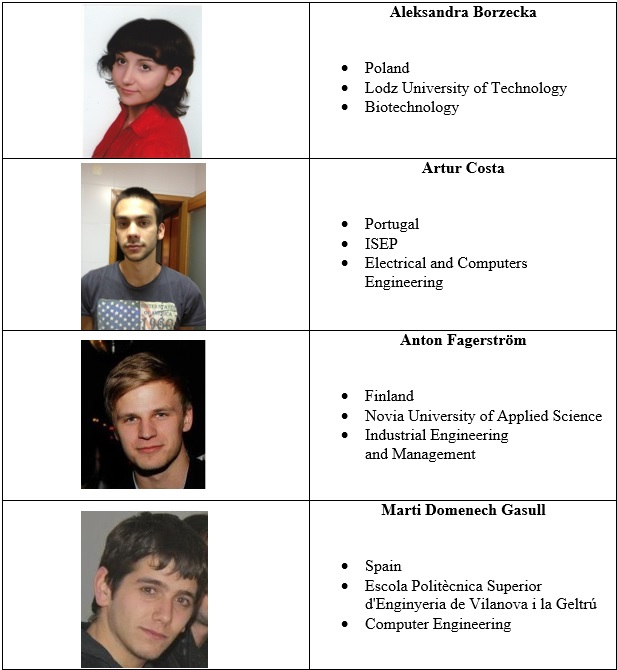
Problem
Develop and design a pet tracking device that complies with the following requirements:
- Web interface;
- Display track using Google Maps/Google Earth;
- On board data storage;
- Data download Interface;
- Light, small, portable, wearable device;
- At least 48 h Power autonomy;
- Use open source technologies;
- Comply with the following EU Directives:
- Machine Directive (2006/42/CE 2006-05-17);
- Electrical Safety: Low Level Voltage Directive (2006/95/CE 2006-12-12);
- Restriction of Hazardous Substances (ROHS) in Electrical and Electronic Equipment Directive (2002/95/EC 2003-01-27);
- Mandatory adoption and use of the International System of Units (The NIST International Guide for the use of the International System of Units)
We wanted to offer something extra in addition to normal Global Navigation Satellite System (GNSS) tracking. In addition, our product will include activity monitoring. This feature will allow the owner to keep track of the pet’s activity and schedule the exercise it needs.
Motivation
We are pet owners and we would never want our own pets to go missing. This motivates us through the project. We are young engineers who want to put our knowledge into something useful for the world.
Objectives
The main objective is to design and develop a pet tracking system that complies with the requirements described in 1.1. Once the main problem is solved, we want to create a unique environment where the pet owner can, not only know the pet’s location accurately, but also monitor its levels of activity during the day and share it on social media.
Expected Results
The product needs to meet the original requirements to satisfy our client, José Barros Oliveira. In addition to these basic features, we intend to offer activity monitoring. The following features will be available:
- Locate your pet with Google maps.
- See the trail of where your pet has gone during the day.
- Monitor your pet's activity to ensure that they get enough exercise to stay healthy.
- Share your pet's activities on social media.
Work Plan
A Gantt chart was created to give us a good overview of our project. We also created a task list to assign specific tasks to specific team members depending on what they preferred and their previous knowledge.
Gantt chart
In order to plan the events related to the project development, a Gantt chart (Figure 1) was created. This chart was very useful to plan and manage team work.
Figure 1 - Gantt chart
Task list
Tab. 2 Table of tasks
| Task | Responsible |
|---|---|
| Search components and materials | All |
| Marketing Plan | Anton |
| Design | Anton and Ola |
| Web interface | Marti |
| Electronics and automation | Artur |
| Communication | Artur and Marti |
| Eco- Footprint and Sustainability | Ola |
| Ethical and Deontological Concerns | Anton and Ola |
| Final presentation | All |
| Final tests | All |
| Video, Paper Poster | Ola |
Report structure
This report is structured in seven chapters.
The first chapter is the Introduction and presents the problem, the motivation, the objectives, the expected results.
The second chapter is the State of The Art and presents a general view of similar products in this area. It also presents technologies we used to create our product.
The third chapter is the Marketing Plan and presents market environment analysis, SWOT (Strengths, Weaknesses, Opportunities, and Threats) analysis, market segmentation, marketing targeting and positioning, marketing mix, use of advertisment budget and conclusion.
The fourth chapter is the Eco-efficiency Measures for Sustainability and presents what is a sustainable product, what kind of materials we are going to use and how they influence the environmental, social and economic life.
The fifth chapter presents our Ethical and Deontological Concerns for the project.
The sixth chapter is the Project Development. It presents the materials used, the system architecture, modules used, functionalities and the final test requirements.
The seventh chapter includes our conclusion of the project as well as suggestions for future developments.
After conclusion it is the bibliography and appendixes.
State of the Art
Nowadays it is possible to find products for almost anything, and a pet tracker is not an exception. A Pet Tracker is a device used to monitor and track one’s pet location, and it can be used for different purposes. These devices are used by hunters to keep track of the hunting dogs, and by regular pet owners to assure that the pet is safe at home or to find it in case it has ran away.
In the process of designing this product there are many aspects that have to be considered. The major ones are the location system, a mean of communication, the power supply and a system controlling device.
This chapter will present some of the most relevant currently systems and technologies that can be used to build a Pet Tracker, as well as some products offering similar features to the Pet Tracker we propose.
Related Projects and Products
There are several products that allow a pet owner to track its pet. We have studied two different types of products and labelled them by their operating range (or communication system). These devices use GPS or GSM to acquire one’s pet location, and communicate with the owner using either the GSM/GPRS network or a RF transceiver pair
The GSM/GPRS network ranged pet tracking allows the owners to monitor and track the pet since they can just use the manufacturer’s interface, simply using a smartphone or a computer, therefore excluding the need to purchase a specially designed handheld device. The range of these devices depends on how much the telecommunication industry is developed in one particular area.
When it comes to accuracy, although many use the name GPS in their product name, a GPS module is not included in the device so it can be imprecise due to its dependency on the telecommunication antennas, needed to calculate the position based on multilateration. When the GPS module is used, the device becomes more accurate but it also reduces the device’s power autonomy
The price of this type of device is fairly low, but it is required the payment of a monthly fee that will cover the communication costs, and that should be taken into consideration.
Table 3 draws a comparison of some of the more relevant products.
Table 3 GSM/GPRS network ranged trackers[3]
| Product | Size | Battery life | Price | Monthly cost | Activation |
|---|---|---|---|---|---|
| Tagg | For pets 4.5kg and up | Average:14-20 days Travel: 3-4 days | 77 EUR | 6 EUR | 0 EUR |
| Loc8tor Pet GPS | Not for small breeds | 4-10 days with typical use | 290 EUR | 12-40 EUR | 0 EUR |
| LovemypetsGPS | Not for small breeds | 2 weeks on standby | 175 EUR | 12 EUR | 15 EUR |
| SpotLite GPS | For pets 4.5kg and up | 5 days with typical use | 115 EUR | 15 EUR | 23 EUR |
| Retrieva | For pets 4.5 kg and up | 5-10 days with typical use | 300 EUR | 8 EUR | 0 EUR |
From the listed products only Tagg, based on the United States, offers activity monitoring.
While the GSM based products are good for the everyday pet owner, hunters may take some advantages from the RF locators. These devices are more robust and responsive and are prepared for rough environments. These devices also allow tracking up to 15 dogs simultaneously . These factors also originate a higher investment, although there is no need to pay monthly fees. The battery life is reduced as well as the range–as presented on Table 4.
Table 4 RF ranged trackers[3]
| Product | Size | Battery life | Price | Range |
|---|---|---|---|---|
| Garmin Astro | Medium to large sized dogs | 20 hours | 440 EUR - 500 EUR | Up to 14.5 km |
| Sportdog TEK GPS | Medium to large sized dogs | 20 hours | 350 EUR - 540 EUR | Up to 14.5 km |
| RoamEO | Medium to large sized dogs | 20 hours | 150 EUR - 215 EUR | Up to 11.3 km |
Technologies
This section will present a study and comparison of different technologies considered to this project. It will discuss wireless communication, location, microcontroller and battery technologies that can be found in today’s market.
Wireless Communication
With a strong presence in our society, wireless systems allow us to transfer information,communicate, between two or more points that are not connected by an electrical conductor[4]. There are many ways of communicating without any wires but there are some thathave a growing impact in our lives.
- WiFi – Very popular technology that allows an electronic device to exchange data wirelessly (using radio waves) over a computer network. This technology refers to the IEEE 802.11 standard. A device that is able to connect to a WiFi network can make use of the internet and use it to communicate with other devices [5]. This connection can be established using the correct hardware: a wireless adapter (ZigBee, USB Adaptor, WiFi module) and an access point to connect to. This technology is limited to the access point range, which may vary from 20 meters indoors to greater outdoors range like 100 meters, and the adapter’s characteristics.
- RF Modules– These modules consist of small electronic circuits used to transmit/receive information [6]. The RF signals are commonly modulated in amplitude (ASK), frequency (FSK) and On-Off (OOK). To be able to communicate it is necessary to use one transmitter and one receiver, and there are limitations when it comes to range.
- Bluetooth Modules – With a physical range varying from 1-100 meters, this wireless technology is a standard for exchanging data over small distances. Useful in low-bandwidth situations, Bluetooth is commonly used to transfer sound data with telephones (i.e., with a Bluetooth headset) or byte data with hand-held computers (transferring files) [7].
- GSM/GPRS Modules – These modules are used in the mobile phone industry as the main communication device. The range of these devices is restricted by the presence of telecommunication antennas, but there is coverage for this network anywhere one can use a mobile phone. The GSM standard was developed as a replacement for first generation analog cellular networks, and originally described a digital, circuit switched network optimized for full duplex voice telephony. This was expanded over time to include data communications, first by circuit switched transport and then packet data transport via GPRS [8], [9].
Table 5 provides a comparison between the several features of the selected wireless communication technologies.
TabLE 5 Wireless communication technologies comparison
| Technology | Range | Limitations | Cost |
|---|---|---|---|
| WiFi | Up to 100 m | Range of the access points | Low |
| RF modules | Up to 20 km | The need for a transmitter and a receiver | Low |
| Bluetooth Modules | Up to 100 m | The need for a transmitter and a receiver | Medium |
| GSM/GPRS Modules | World wide | Operation expenses | Medium |
Location System
There are many approaches when it comes to location. One can think of a street, a room or a remote spot on the desert. In this project, location refers to geographic coordinates (latitude, longitude and altitude). There are numerous ways to determine location using navigation tools, being the most commonly divulged the Global Navigation Satellite System (GNSS). It is also possible to determine one’s position using radar (RAdio Detection And Ranging), GSM (Global System for Mobile Communications), Wi-Fi and other radio tools.
- GNSS – This system makes use of artificial satellites that transmit time signals and allow electronic receivers to determine latitude, longitude and altitude [10]. There are operational GNSSs in the United States (Global Positioning System - GPS) and Russia (Globalnaya Navigatsionnaya Sputnikovaya Sistema - GLONASS). Some other systems are being developed in China (Compass) and Europe (Galileu). These systems are typically used in tracking and navigation and are becoming more established in our society every day. This is an accurate and reliable location system when used outdoors.
- Radar – Mainly focused on object detection by means of radio waves, it is typically used in aerial, maritime and terrestrial navigation. It is more commonly used for military, astronomic and meteorological purposes [11]. Although it is a reliable system, it implies a great investment in the antennas, and its range is proportionally limited to that same investment.
- GSM – Even though this is not directly a location system, the mobile device industry has turned it into one. This technology makes use of the nearby telecommunication antennas to determine the GSM module’s location – using multilateration. This technology does not present considerable limitations when it comes to indoors use, but its accuracy relies on the number of telecommunication antennas nearby.
A summarized comparison of each considered location system’s accuracy, limitations and component’s cost is presented in Table 6.
Table 6 Location system comparison
| Technology | Accuracy | Limitations | Cost |
|---|---|---|---|
| GNSS | 1 m – 10 m | Indoors | Low |
| Radar | 3 m – 5 m | Infrastructures | High |
| GSM | Up to 1 km | Telecommunication antennas | Medium |
Microcontroller
A microcontroller is a programmable integrated circuit, capable of executing commands stored in its memory. It is used to control and automate electronic and electro-mechanic systems. Due to future references on single-board microcontroller (or development board), the present exposition will refer to such products. A single-board microcontroller is a microcontroller built onto a single printed circuit board [12], PCB. We can find a wide quantity of such products in the market but they all have the same common aspects: microcontroller, Input/output circuits, clock generator, RAM – Random-Access Memory and stored program memory. These devices are typically low-cost and very effective, offering an easy way to evaluate microcontroller chips.
- STM32F4 Discovery – Produced by STMicroelectronics, this board is very powerful and versatile. It contains a STM32F407VGT6 microcontroller, based on the Cortex M4 processor, at 168 MHz with 1Mbyte flash and 192kbyte SRAM, Static RAM [13]. This board also includes an accelerometer, a microphone and a great amount of pins to interface.
- Arduino Pro Mini – Based on the ATmega168, it has 14 digital input/output pins, 6 analog inputs, an on-board resonator, a reset button, and holes for mounting pin headers [14]. This board is intended for semi-permanent installation in objects or exhibitions, and it is suitable for small projects that do not require large processing capabilities.
- MSP430 LaunchPad – Based on the MSP430G2x Value Line MCUs (Microcontroller Unit), this 10 USD board offers ultra-low power consumption, 16 kbyte flash, a 512 bytes SRAM and 20 pins. This device features a powerful 16-bit Reduced Instruction Set Computer (RISC) central processing unit (CPU), 16-bit registers, and constant generators that contribute to maximum code efficiency [15], [16].
- Raspberry Pi(Model A) – Developed in the United Kingdom by the Raspberry Pi Foundation, aims to promote teaching basic computer science in schools. With the ability to run a Linux based operating system, this device is loaded with a 700 MHz ARM1176JZF-S core (ARM11 family), 256 Mbyte SRAM, HDMI/RCA/DSI (High-Definition Multimedia Interface/Radio Corporation of America/Display Serial Interface) video outputs and power ratings at 300 mA (1.5 W) [17], [18], although some users have complained that the real power consumption is higher.
Table 7 draws a comparison between the mentioned single board microcontrollers.
Table 7 Single-board microcontroller comparison
| Board | Frequency | Input Voltage | Flash | Dimensions |
|---|---|---|---|---|
| STM32F4 | 168 MHz | 3.3 V - 5.0 V | 1 Mbyte | 9.7 x 6.6 cm |
| Arduino Pro Mini | 8 MHz - 16 MHz | 3.3 V - 5.0 V | 16 kbyte | 3.3 x 1.8 cm |
| MSP430 LaunchPad | 16 MHz | 1.8 V - 3.6 V | 16 kbyte | 6.8 x 5.1 cm |
| Raspberry Pi | 700 MHz | 5.0 V | - | 8.6 x 5.4 cm |
Battery
A battery is a device consisting of one or more electrochemical cells that convert stored chemical energy into electrical energy [19] and vice versa. This device can either be rechargeable or not, and this project has in consideration the ecological footprint, the mid/long term economic and maintenance concerns as well as the consumer’s comfort, hence the use of rechargeable batteries. This narrows the types of batteries and battery chemistries to study.
- NiCd – uUsing nickel oxide hydroxide and metallic cadmium as electrodes, the NiCd is used in applications that require long life, high discharge rate and low price. Main applications are two-way radios, biomedical equipment, professional video cameras and power tools. The NiCd contains toxic metals and is not environmentally friendly.
- NiMH – This type of rechargeable battery uses positive electrodes of nickel oxyhydroxide (NiOOH) and the negative electrodes use a hydrogen-absorbing alloy [20]. NiMH batteries will not perform well in high rate discharge applications, typically providing only a small fraction of the rated capacity in these instances. NiMH batteries have higher energy than NiCd battery, but they have higher self-discharging rate and shorter shelf life.
- NiZn - These batteries have a charge/discharge curve similar to 1.2 V NiCd or NiMH cells, but are able to provide a higher 1.6 V nominal voltage. Low cost, high power output and good temperature operating range make this chemistry attractive [21].
- Lead-acid - This is the oldest type of rechargeable battery, are suitable for larger power applications where weight is not a concern [22]. Despite having a very low energy-to-weight ratio and a low energy-to-volume ratio, their ability to supply high surge currents means that the cells maintain a relatively large power-to-weight ratio. Some lead compounds are extremely toxic and long-term exposure to even tiny amounts of these compounds can cause brain and kidney damage, hearing impairment, and learning problems in children [23].
- Li-ion – Emerged in the early 90’s, it has a high energy density, a relatively low self-discharge rate, no need for maintenance as well as the ability to provide high current to a system. This type of battery has some limitations, mainly in its maturity and the requirement for a protection circuit in order to maintain the voltage and current within the safe limits [22]. The Lithium ion chemistry is lightweight, does not contain toxic metals like the lead acid batteries and lasts long enough to span the typical life of the product.
- Li-Po – Similar to the Li-ion batteries has its main advantages by being lightweight, very low profile, resistance to overcharge and the low chance for electrolyte leakage. On the other side of the scope it may become more expensive than the Li-ion as far as the cost-to-energy ratio may concern [22].
Table 8 draws a comparison between several different types of batteries.
Table 8 Battery Comparison
| Battery type | Cell Voltage (V) | Specific Energy (MJ/kg) | Self-discharge/Month1) | Maintenance Requirement | Cycle Life 2) |
|---|---|---|---|---|---|
| NiCd | 1.2 | 0.14 | 20% | 30-60 days | 1500 |
| NiMH | 1.2 | 0.36 | 30% | 60-90 days | 300-500 |
| NiZn | 1.6 | 0.36 | 8% | Not required | 400-1000 |
| Lead-acid | 2 | 0.14 | 5% | 3-6 months | 200-300 |
| Li-ion | 3.6 | 0.46 | 10% | Not required | 500-1000 |
| Li-Po | 3.6 | 0.48 | 10% | Not required | 300-500 |
Conclusions
Based on the previous comparisons, we decided to design a quality product that is reliable and accurate as well as economical and practical. To make this possible we selected a GPS module, a GSM/GPRS module, an Arduino Pro Mini single-board microcontroller and a Li-ion battery to power all the components.
The GPS’s choice is related to its accuracy and cost. To balance its limitations we are also using a GSM module to cover the indoor location and to provide an independent communication mean.
To control the system we decided to use the Arduino Pro Mini at 8 MHz because we are not looking for extreme frequency processors and it is small enough to fit in a pet collar. The lower frequency also reflects in the controller’s power consumption. To power up the system we chose a Li-ion battery due to its specific energy, cell voltage and cycle life characteristics.
Marketing Plan
Market analysis
Current market situation
Our product will be the first of its kind to be produced in Europe. There are other GPS trackers in Europe but none of them offers activity tracking. This is the feature that will make our product unique for the European market. There is only one company that offers the same kind of features in their product and they are located in the United States. We need to be prepared to compete with other big companies that might enter the market after us if our product is successful. Gadgets tend to have a short life cycle. They “mature” very quickly. To counter this problem we will have to continuously develop the system with new features after the first product has been released. A product that creates a need to use it will be a successful one e.g. Facebook, Twitter. Since our tracker can be used to secure that your loved ones are okay, pets or humans, it finds a place in Maslow’s hierarchy of needs (Figure 2) with “Love/belonging”. The need to know they are safe.
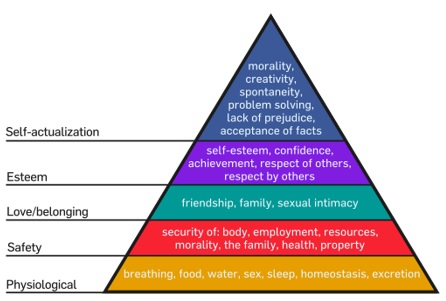
Figure 2 Maslow's hierarchy of needs
Market dimension
We are aiming at the Finnish market. The Finnish monthly median gross income is set at 2776 EUR [24]. This means that Finns might have some extra money to spend on their pet. There are approximately 600 000 registered dogs in Finland at the moment of which about 450 000 are purebred [25]. Purebred dogs are more expensive and an owner of a purebred dog might be willing to spend a little extra to make sure that these dogs are not lost. For many Finns, their dog is not only a member of their family, but a whole lifestyle which includes shows, training, sports trials and being involved in canine clubs. Agility, hunting and obedience training are among the most popular activities besides attending dog shows. There are about 300 dog shows in Finland with a total amount of dogs attending of 195 000 every year [24].
PEST analysis
The Political, Economic, Social and Technological analysis can be used to identify macro-environmental factors that might have an impact on a company in a certain country. These factors have to be taken into consideration when you launch a new product to a market.
Political/ Economical
As a rule, sales of goods to customers in the EU internal market are taxed in the country of sale. Distance selling from one Member State to another is an exception to this rule. Distance selling takes place when a supplier from one member state supplies goods and is responsible for their delivery to a private individual or a non-VAT-registered person in another member state. If our sales to Finland would exceed 35 000 EUR per year, we will have to register our company for VAT in Finland. If we exceed 35 000 EUR we will have to pay 24% instead of 23% in valued added taxes. In Finland, most online consumers prefer to pay via their Internet banking system. Therefore, it would be a good idea to include direct payment functionality in our web shop. Sales to customers in Finland are subject to the provisions of the Finnish Consumer Protection Act, which states, for example, that it is the seller who is to pay the return freight if the customer wishes to cancel the purchase and return the product.
Social/ Technological
A social-cultural trend right now is that people compete in showing on social media that their life is more exciting than other’s. We can add another component to this “race”. The added component would be: “I take care of my dog better than you”. Social comparison is a remarkably ubiquitous process which influences how people think about themselves, how they feel, what they are motivated to do, and how they behave [26].
Fitness and health gadgets are trending now in 2013. Consumers Electric Show is a major technology-related trade show held each January in Las Vegas and this year there was an estimated increase of 25% of these kinds of gadgets compared to last year. Our product fits in this category as well but with a small alteration since we are focusing more on the health of the pet instead of the owner. Indirectly this may also give the pet owner a more active life as well when/if the dog need more exercise.
Main competitors
Our main competitors are Garmin and Snaptracs (Whose products are referred to in Chapter 2 (State of the art).
Garmin
Garmin is a well-known navigation company from Switzerland. They provide navigation systems for all kinds of vehicles and activities as well as equipment specialized for hunters. In their animal department, Garmin offers dog tracking and pet obedience products. The quality of their products is of high standard but a high price follows. Their cheapest complete dog tracking system is set at 500 EUR and it includes a handheld device worth 300 EUR and a collar worth 200 EUR (Figure 3).
Figure 3 - Garmin Astro
This product is a collar with a built-in module and antenna. Their products can handle up to twenty dogs, simultaneously depending on the model of the handheld device. Garmin's dog tracking products are mainly used by hunters. Our product will offer basic GPS tracking of animals at a much lower price than Garmin, provided that the pet’s owner already have a smartphone and/or computer.
Snaptracs
Snaptracs is a Qualcomm company. Qualcomm is an American semiconductor company that specialize in wireless telecommunication. They have one product called “Tagg” (Figure 4)
Figure 4 - Tagg
Snaptrack's “Tagg” is not aimed for hunters but for regular dog owners that wish to keep track of their dogs. The product is small with a sleek design. Tagg is currently priced at 100 EUR. This price includes a three month GSM service. After three months you have to pay 7 EUR (+1 EUR per additional pet) per month. The Tagg product will be our main competitor since they are in the same market we are aiming at (regular pet owners) with a competitive price.
SWOT-analysis
The SWOT-analysis for our product and the Finnish market can be found in Table 9:
Tab. 7 SWOT analysis
| Strengths +30 | Weaknesses -21 |
|---|---|
| Young adaptive development team +5 | Young development team -3 |
| Uses new technology +5 | Lack of position on the market -5 |
| Open source technologies +4 | Limited financial resources -5 |
| Easy to use +5 | Limited amount of time to develop product -3. |
| New product on an untouched market. +4 | New product on an untouched market. -2 |
| Main competitor does not have a strong position in the European market +4 | Lack of experience in product development. -3 |
| Patronage of ISEP +3 | |
| Opportunities | Threats |
| Create demand for such products +4 | Product acceptance -4 |
| 600 000 registered dogs in Finland +5 | Easy for big companies to copy/improve -5 |
| EU +4 | Main competitor drop their prices -2 |
| Median monthly gross income in Finland is 2776€ +4 |
The SWOT-analysis shows that our product has more strengths than weaknesses. We can become leaders of the market if the product is accepted and the demand is big. There are both pros and cons when you introduce a product to an untouched market.
Market segmentation and targeting
To divide properly a broad market into small segments comprising of individuals who have similar needs, requirements and interests the process called Market Segmentation has to be done. Three main categories are taken into considerations:
- Geographic segmentation
- Demographic segmentation
- Psychographic segmentation
Geographic segmentation
The target market for the Pet Tracker is North Europe, more precisely –Finland. This decision was made due to the fact that the citizens are great animal lovers and at the same time there is a huge possibility that the average person could afford a product offered by us. The rest of Europe is also included in a plan although countries like Spain, Poland or Portugal cannot ensure such a big success as Finland.
Demographic segmentation
The main factors affecting this part are:
- Income – the citizens whose average month salaries are at least at the satisfactory level (not less than national average) and actually who live in the countries not affected by the crisis, are our most target group.
- Occupation – we assume that the clients whose professions in everyday life are connected with animals (e.g. veterinarians, breeders, farmers) are more likely to buy a Pet Tracker due to their specific job than other consumers.
- Education – the type and level of education may affect the attitude towards the animals and result in willingness to buy such a product in emergency case (loss of pet).
Variables such as age, gender, religion or race are not included in demographic segmentation process since they do not influence the demand for our product.
Psychographic segmentation
Clients may be divided into different groups based on:
- Social class – consumers from the middle and higher class are assumed to be much more interested in potential purchase of Pet Tracker
- Lifestyle and personality – clients whose job and lifestyle are already strictly connected with animals as well as regular pet owners are more receptive to innovations appearing at the market
Segmentation criteria on business market
Needs approach
We are getting out in front of the customer expectations which are related to obtain a good quality product for a reasonable price. The main advantages of Pet Tracker are:
- General accessibility - based on a client opinion survey we decided to introduce a product for online shopping as well as to the usual, local pet shops and supermarkets. The animal health centres are also taken into consideration.
- Ease of everyday use - user-friendly web interface is available for all internet compatible devices on the market. Besides, the collar attachment makes sure that the Pet Tracker fits a wide range of collar sizes and can also be attached to belts or other human clothing which gives a huge flexibility.
- Durable and lightweight module – the animal should not be burdened by a heavy and bulky module with pointy antennas. The durable exterior of our product is made to withstand all possible weather conditions while not limiting the features.
From the engineering point of view our main goal is to provide the clients with a product of highest quality for the lowest price.
Purchasing approach
The next aim is to acquire new customers who are not familiar with this type of product before as well as try to convince people that already own another company’s pet tracking system to purchase our Pet Tracker instead (we can do so by comparing it with other companies offering similar ones and pointing out our main strengths)
Results of the survey created by our team (answers collected from 64 respondents from 12 different countries) are presented in Appendix A.
Market positioning
Positioning of the product is an extremely relevant part of the marketing strategy. The main goal is to create a positive perception of brand in the eyes of the public. Clear, unique and advantageous position has to be occupied in consumer’s mind. The Pet Tracker has to be perceived as more noteworthy than other available products because of its unique feature (offering both tracking and activity monitoring mode). Therefore, the positioning must be carried out in a consistent manner and with a defined purpose.
The best start for any positioning analysis is gaining a thorough knowledge of a product or service's target market which was already done by our team. Couple of things have to be taken into consideration in the market positioning process such as:
- Positioning in advertisements the intended target is group of pet lovers and people whose job is associated with the animals. That is why we can create two different advertisements: first one for the regular pet owners and the second one – more professional. Regardless of the target group, all advertisements (e.g. magazine spots) have to be joyful and presenting the pleasure and advantages of using the Pet Tracker. We want to create an overall identity for our brand and convince in the same time the potential clients how much we care about the relations between animals and their owners. To reach the customers and make them feel more integrated with our company, the recurrent photographic sessions with pets may take place and be put on the website as a part of advertising.
- Positioning in sales locations – reaching the customer is not only a matter of advertising, but also a matter of choosing the right channels for future distribution. A product should be placed as close to the target market as possible – for us it would be Finland and neighbouring areas to ensure an easy access for everyone to buy the Pet Tracker (either personally or by the Internet) as well as offer the possibility of service points, in case of any problems with the device.
- Positioning through price – regarding the fact that usually customers associate a higher price with higher quality and the opposite with a lower price, the appropriate balance between those two factors has to be maintained. Our product will be positioned as a good, reasonable alternative to high-priced brands offering similar devices, to attract the clients and influence them to purchase the Pet Tracker.
Marketing MIX
The marketing mix is a business tool used in marketing products. The marketing mix is often crucial when determining a product or brand's unique selling point. The four P's (or four C’s) are the following:
- Product/ Consumer
- Price/ Cost
- Promotion/ Communication
- Place/ Convenience
Product/ Consumer
Our product is a tracking and activity monitoring device. It uses a GPS module in combination with a GSM/GPRS module to accurately localize your pet and show where it is on a website with Google maps. The website is accessible with both mobiles and computers. The RWD (Responsive Web Design) allows it to be browsed by all devices, independently of the software they are using. The built-in triple axis accelerometer stores data about how active your dog has been during the day. Everything is controlled by an Arduino Pro Mini board and powered by a Li-Ion battery. The product will only be available in white during the product launch but the selection of colours will get bigger during the autumn (Figure 5).
Figure 5 - Concept design
Price/ Consumer
The final price will cover:
- Material
- Advertising
- Packaging
- Profit
- Labour
- Building
Cost of product
We have calculated the price for three different versions of our product (Figure 6): the prototype, a mass produced product with same components as the prototype and also the price of our next product.
Figure 6 - Three different versions of the Pet Tracker
Prototype
The material costs will be higher for our prototype than a mass produced product since we are limited to buying components that can be found in Porto and the price for a single component is higher than when bought in bulk. The price could be lower if these restrictions did not exist because then we could by cheaper components from e.g. China and in bulk mass. As for the price for the prototype, we can only give the price that covers the total material cost which is 279.55 EUR/ unit. This price includes:
- Cost of components (216.95 EUR VAT included)
- Delivery of components to Porto and profit for the company that handled our request. (62.60 EUR)
Mass production of prototype
We did a calculation of what it would cost to buy larger quantities of the same components we used in the prototype and ended up with a sum of 180.59 EUR/unit including VAT. (Appendix B). This reduced price of the components was achieved by buying 100 of each component, from the same vendor as before, instead of 1.
The final price for consumers will be 230 EUR. This price includes all fixed costs, the three month service that comes with the purchase and profit for us.
This is the price we will use when we calculate breakeven in the budget chapter later on.
Future version of product
We have also searched for components that could be used in future versions of our product. The future version will not need breakout boards and we can use a simple microcontroller instead of the Arduino. We will also use a different GPS module and antenna, the rest of the components will stay the same (Appendix B). The material cost for the future version is 116.24 EUR/unit.
Cost of service
There will be a cost for using our device. The GSM/GPRS service requires a SIM card to operate. TeleFinland is a telephone operator in Finland and they offer the cheapest telephone subscription that meets our needs. This subscription will let us send 1000 SMS messages for 5 EUR/ month. The product comes with a 3 month package. After this you will have to buy additional service packages.
Our service can be bought in the following packages:
- 3 months package – 19.99 EUR
- Half year package – 34.99 EUR
- Full year package – 64.99 EUR
The price covers the cost of the subscription plus an additional 4.99 EUR that we charge for handling the subscriptions. The price of our service changes accordingly to TeleFinland's pricing. The service can be cancelled anytime but no refund is given on an already started service package. The service cannot be paused.
Payment methods available for customers will be:
- Bank transfer
- Credit card
- PayPal
- Bitcoin http://bitcoin.org/en/
Promotion/ Communication
We will use different types of promotions. Since dog shows are very popular in Finland, this will be the best place to have a product demonstration and get in contact with our first potential buyers. Product demonstrations at veterinary conferences might also be beneficial. Posters and leaflets can be handed out at veterinarian offices, dog shows and fairs. We can also send products to different product review websites e.g. the Verge (www.theverge.com), known bloggers and other relevant websites that can test our product and write an objective review about it. The following dog journals are the biggest ones in Finland and a review of our product in one of these might give good publicity:
- Meidän koira (http://www.karprint.fi/meidankoira/)
Social media, such as Facebook, is a good place to spread information about our product. Our company will have its own page where we can promote different offers or competitions that users can take part of if they share it with their friends. This is a cheap and effective way to spread the word about smaller companies and new products.
Place/ convenience
The product will be available for purchase on our website during the launch of our product. To keep the shop online is cheap, it can reach a big market and a customer can do his/her shopping 24/7 without leaving his/her home. Distribution will be outsourced as it is a cheaper for us than creating our own department, at least at this stage. Products will also be sold when visiting dog shows and fairs. When the product becomes more popular and demand rises we can start distributing to retailers as well.
Action program
The Pet Tracker will be introduced to the market in July of 2013, shortly after a demonstration at Instituto Superior de Engenharia do Porto (ISEP) in June. This chapter gives an overview of what will happen during the first year.
Note: All dog shows that we will visit have been handpicked for their visitor count to ensure that as many as possible will see our product.
| Month | Action |
|---|---|
| June | Product demonstration at Instituto Superior de Engenharia do Porto in Portugal. Launch webpage and create a Facebook page for the company and the product. |
| July | Introduce the product to the Finnish market for the first time at a dog show in Oulu. Start to use Google adwords into use i.e. paying to show our link first when someone types “Pet Tracker’ on Google. Order 1000 leaflets, 100 A2 Posters and a roll-up poster from Julistetehdäs in Finland. Send 2 products for review to The Verge and Meidän Koira. Translate our webpage to Finnish, Swedish, Portuguese, Spanish and Polish. Pay for advertisement of product in the Koiramme magazine. |
| August | Show product at the Joensuu dog show. Contact potential buyers and buyers from last dog show to receive feedback and to maintain a good relationship with customers (This will be done after each dog show). Send leaflets to different veterinary offices and dog pounds. |
| September | Visit Eckerö dog show. Use feedback to improve website or other services. |
| October | Visit Seinäjoki dog show. |
| November | Visit Jyväskylä dog show. Start preparing for the biggest dog show in Finland, Koira 2013. Send product for review to the Koiramme magazine and the Life With dog’s blog. |
| December | Visit Koira 2013 in Helsinki. Make contact with customers from other countries. Analyse our progress and results to and make adjustments if needed. |
| January 2014 | Pay for advertisement to remind visitors of Koira 2013 about our product. Make a “Share and like to win” contest on Facebook to get more followers for our page. Visit Turku dog show. |
| February | Start to plan action programme, budget and control for our next product. Visit Helsinki dog show. Announce winner of Facebook contest. |
| March-June | Visit Jakobstad, Kokkola, Vaasa and Tampere dog show. Send out message to owners of Pet Tracker that a new version will be launched in the end of this year and that previous owner, with active subscriptions, are entitled to a discount for the new one if they write 200 words of feedback for the old one. |
Budget
Marketing expense budget
Our budget for promotion of the company and the product for the first year is 5000 EUR. Table 10 shows how we intend to use it during our first year starting from July.
Table 10 - Marketing expense budget
As it can be seen in the table above, we intend to use our promotion money a bit strategically. We use more money at certain points during the year instead of using a little money all the time because we believe that it is better to have big advertisements once in a while rather that small ones that are hard to notice.
Breakeven
If we set the price for the product at 230 EUR, we will breakeven after we have sold 524 units. This was calculated with the following formula:
Fixed cost / (Price – Variable costs) = Breakeven points in units.
18000 EUR / (230 EUR - 195.59 EUR) = 523.10 units.
Control
The company has to observe both micro and macro environment all the time to ensure that we can meet customer needs. We need to study existing competitors as well as new ones that enter the market after us. Companies that ignore changes on the market will be left behind. We have to stay updated on how political and economic changes in the market environment. It is also very important to follow the technology progress on navigation systems and components to be able to develop our product and thereby give our customers the most up-to-date services and products. We have to follow the social trends to ensure that we do not get left behind. The controlling process must be continuous in order to stay attractive to the customers on the market. This process can be illustrated as in Figure 7.
Figure 7 - Manage and control [29]
Conclusion
The marketing plan describes our market segments and strategies that will be used to reach the market. When analysing the microenvironment, we found that there are other tracking systems as well but they do not offer activity monitoring and GSM combined with GPS tracking. We are aiming for the European market, more specifically Finland. The product is targeted at anyone who wants to make sure that their animal does not get lost or that it receives enough exercise to stay healthy.
Eco-efficiency Measures for Sustainability
Introduction
While working on the project, the eco-efficiency as well as sustainability has to be taken into consideration. As future engineers, we need to keep these factors in mind while creating different technical solutions to the problems.
A very simple definition can be used to present how exactly we understand term of eco-efficiency. We may describe it as a business strategy which mainly relies on rule “doing more with less” [30]. It is necessary for us to imply it in our project to fulfil the task and create the best product in the most effective way, according to such assumptions as e.g. increasing a value of the product, optimizing the use of resources or reducing environmental impact.
It is highly possible to reach a goal through focusing on those three main objectives which may help our product to become more eco-friendly, but still fully applicative in the same time. We believe that this strategy could let the Pet Tracker be innovative and recognizable on the market.
Moving to the sustainable development, we may describe it as a balance between three main cores such as economy, society and environment, held together for the current and future generations [31]. Sustainable means reasonable – in this case, it is the way of making the best decisions for the “common good” through different steps of creating a product. Distinct points of view have to be analysed regarding this topic, which is well presented by the picture below (Figure 8):
Figure 8 - Three main cores of sustainability [32]
Considering the maintenance of sustainable development we focused mainly on this diagram, which in our opinion, is a great reflection of most significant aspects in following matter. Moreover, eco-efficiency issue cannot be discussed without taking into consideration sustainability part in the same time.
Environmental
In order to meet our needs, it will be necessary to cause an environmental impact. However, we can do it without compromising the next generation’s ability to meet their needs. Therefore, some measures will have to be planned.
This is a technological project so a great importance has to be given to the new and more efficient devices developed every day. Being close and supportive to technological progress will be mutually rewarding. This measure contributes to the device’s efficiency and consequently reduces its ecological footprint.
Material and manufacturing process control is another responsibility we would like to take. With this measure it is intended to control and reduce the material and resources usage and the waste produced. Making sure that the process is as efficient as possible will result in reduction of the material extraction.
Making sure that the material is as durable and recyclable as possible is another topic to focus on. Using durable and recyclable materials will help reduce our ecological footprint and make our customers happy. We also want to participate in electronic device’s disposal services. This way we can reuse components and send the remaining ones the appropriate disposal centre.
Another goal is to have sustainable facilities. Good isolation, efficient electric utilities and responsible and eco-friendly behaviour will contribute to savings and will help the environment. Also, if possible, work from home.
When planning the manufacturing process, it is important to buy in bulk and, if possible, buy local. This factor is significant in order to reduce the ecological footprint of the product.
Economical
Economic performance
We will meet our customers and stakeholders expectations and contribute towards the well-being of society. This will require efficient, profitable and competitive actions from our company. A good economic performance is needed in order to get a good balance between economic responsibility and the other aspects of sustainability – environmental and social responsibility.
Creating economic added value
We want to provide our customers with high quality and environmentally friendly products, build long-term partnerships with suppliers, offer our employees good compensation and working conditions, and to contribute to the well-being of the local communities in which we will operate.
Employees
In order to employ and keep competent people, we should try to offer our employees competitive salaries, opportunities for continuous personal development in a good working environment. Development of employee skills is beneficial for both the company and the employee.
Pension cover
In Finland most of the pension obligations are covered by the Employee Pensions system (TyEL) [33].
Wage levels
We need to follow the local employment legislation and respect the local collective labour agreements, which often define the minimum wage levels for employees. The base salary will be set to meet market conditions, the demands of the job and individual competence and performance of the employee.
Rules when hiring
All open job vacancies should be published externally and internally to ensure that everyone has equal opportunity to apply for positions. If the position does not require competence transfer from people abroad, then we will hire locally. Same principle applies for senior management.
Tools for sustainability
We need to develop systems and processes to be able to have a continuous improvement/development process. The process would be the following: performance measurement, target setting, taking actions and review of the results. This process can be maintained well if we develop good quality management systems, environmental management systems and risk management systems.
Social
One of the most important aspects to take into consideration when we are working on the sustainability part of a project is the social one. Any company which wants to be competitive needs to contribute to society, and there are lots of issues which requires our attention.
First of all, it is necessary to ensure that a product implies a product responsibility. Health and security of the customer and, in our case, of the pet, must be always a priority, and this is one of the most important concerns for us if we are discussing a social point of view. Obviously, if we provide a client with such a product, the possibility of service maintenance is also a thing we should keep on mind. This service is essential if we are talking about a serious and professional project.
From that point on, there are several measures which we are going to take into account as closely as possible. According to the customer security, our product is going to be harmless. The used materials to make our product are not dangerous and do not contain any sharp angles, which is a relevant measure if we think that the pet can be in constant physical contact with its owner.
In the future, the update of the Pet Tracker will always be a priority. It is a need to keep up to date with the latest technology, and for this reason the project should be in constant development. At the same time, it is always positive to generate economy. In this aspect, we will be always aware of the local situation, trying to promote growth and prioritizing local employment.
Life cycle analysis
Life cycle assessment may be an extremely useful tool to understand the environmental impact associated with every single step during the whole production process of the Pet Tracker.
Figure 9 shows the different stages considered when doing life cycle analysis.
Figure 9 - Life cycle analysis for a product [34]
It is quite hard to assess the exact source of raw materials for different parts of our device, though the outer shell of the product will be made of a renewable material, mainly of ABS plastic. In future development other materials will be taken into consideration e.g. polycarbonate because of its great mechanical strength, mostly resilience and also huge flexibility. However, the material we had already chosen is durable and resistant to different conditions.
The assembly part of this life cycle is in our main interest, due to the fact that we were given all the materials and there was no special need to be focused on the previous steps such as material raw extraction, processing and manufacturing. We created the product from the already existing components. To minimize the costs of transportation, everything was bought at the local supplier’s store. The list of materials is presented more precisely in the “Project Development” chapter.
When it comes to every-day use, criteria such as power consumption and durability might be analysed. According to these factors the most suitable components were chosen, e.g. the accelerometer which is configured to generate inertial wake-up interrupt signals allowing to monitoring pet’s activity and remain in a low power mode while it is not active [35]. Considering probably the most relevant part of our device – a rechargeable Li-ion battery, there are no doubts of choosing this particular one due to its high energy density as well as relatively low self-discharge rate. The battery does not require any specific maintenance and it can work in wide range of temperature. It does not contain toxic metals so there is no risk of harm [22]. Another important aspect is connected with open source web application. The user-friendly web interface is available for all internet compatible devices on the market. By not developing different mobile applications for different operating systems, the development costs as well as the final costs of the product were reduced and the clients are provided with a highly flexible working product. The user manual with all necessary instructions will be enclosed as well to ensure the appropriate usage of the device.
The next step of the life cycle analysis, the end of the product and its disposal, which is a matter of recycling and reuse of the components have to be considered. When our device becomes useless there are few options: either we can exchange the used component of the Pet Tracker (e.g. battery, which is typically supposed to fail after two or three years of usage) in the service point, or we can separate the product into parts and take all of them to the appropriate recycling storage for electronic devices. Li-ion batteries cannot be thrown away as usual waste because there is a risk of exploding when incinerated. The outer shell of the product can easily be recycled again and replaced. The main concern in this step is probably connected to the battery recycling which still is considered to be energy-intensive and expensive process but there is the only way to ensure its proper disposal [36].
Conclusions
Eco-efficiency and sustainability are important in every business aspect and we need to implement it also in our project. We are making the whole process of activity monitoring and tracking much easier than before because we are including pets in social networks and encouraging better relationships between the owners and their animals. We believe it helps with the lost pet problem and contributes to greater awareness of this common problem.
The greatest challenge for us was to find a solution responding to every aspect of eco-efficiency and maintenance of sustainability, not only through production step to marketing and potential future development of a product, but mainly in applying it in the same time to real life use. However, we strongly believe we are able to provide our client and potential customers with competitively priced product which satisfy their needs and increase the quality of life.
Ethical and Deontological Concerns
Introduction
We may encounter different problems not only in everyday life, but also in almost every business aspect. Some of them may be strictly connected with ethics and morality. In such a case the following questions have to be answered:
- Are we able to find the most convenient solution, taking into consideration the “common good”?
- How can we implement the best strategy in our project?
- How exactly do we understand the meaning of ethics in engineering?
- Is it possible to reach success without abusing anybody or anything from an ethical point of view?
- What are our main concerns?
Ethics allows us to follow some obligatory rules and make right choices in order to maintain the good brand image in the future – we want our company to be reliable and well known in the market. That is why the appropriate attitude has to be presented. If we respect our potential employees and customer’s needs, we will achieve our goals as well as become more recognizable and trustworthy. In our case ethics handles with the whole process of the product’s use and disposal not being a risk for anybody in each single step. Firstly, the general engineering code of ethics will be discussed and analysed with reference to our project. Moreover, the main concerns and issues are presented as well in the further part of this chapter.
Engineering code of ethics
As potential engineers, we are obliged to know and implement the basic aspects of ethics in the main areas of our future professions. None of the investments, projects and technical solutions used for the public good may exist without those rules. For the following report the Fundamental Canons from National Society of Professional Engineers (NSPE) Code of Ethics for Engineers were taken into consideration and applied into different issues of our work:
- “Hold paramount the safety, health, and welfare of the public” [37].
The main goal for us in the product development is to create a safe and useful device which will help in both pet’s and owners’ everyday life. Health condition of the animal is the most relevant in this case. All the components and materials are strictly selected to ensure the maximum safety as well as comfort of usage.
- “Perform services only in areas of their competence” [37].
Although we are not engineers yet and we cannot perform the whole project and prototype production on our own, we are still aware of the consequences and responsibility resulting from our work. That is why the great amount of consultations with more experienced in this area professionals was held to avoid risk of making any mistakes.
- “Issue public statements only in an objective and truthful manner” [37].
Concerning the fact that we want to create a trustworthy image of our brand and product, the marketing strategy should be well-planned, especially the part related to promotion. The main goal is to present the Pet Tracker in the simplest and the most accessible way for the client, without hiding any information about the product and its usage.
- “Act for each employer or client as faithful agents or trustees” [37].
We are committed to fulfil the work that we have undertaken and we do our best to meet the expectations of the client. There are certain requirements which we need to follow to ensure the success of the product. Regarding the future of the Pet Tracker, the honest and exact way of presenting its functionalities should be always kept in our minds.
- “Avoid deceptive acts” [37].
We strive to make the entire process of product development proceeded in a clear and explicit manner. If we rely on someone else's information or knowledge, such a thing is always adequately mentioned in the report. Besides, the principles of sincerity and equality of division of work are implemented in our team as well.
- “Conduct themselves honorably, responsibly, ethically, and lawfully so as to enhance the honor, reputation, and usefulness of the profession” [37].
Having in mind both: a good atmosphere within team members and the co-operation, we should always treat each other with respect and politeness. We should support and motivate each other in case of any problems. Our knowledge and skills are the most relevant keys used to achieve a desired goal in a good faith.
Concerns
This section will present the main concerns about this project.
Marketing
First of all, we cannot promise our clients things which we are not sure about. This has to be taken into consideration while developing the promotion and marketing strategy. If we ensure about ease of everyday use of the Pet Tracker and its general accessibility, we have to make it as simple as possible to reach every kind of client and do not use any sophisticated system in our device. Therefore, the way of working (activity monitoring and tracking system) has to be exactly presented to the public. Any kind of doubts (e.g. the battery real-time life) has to be excluded but if it is not possible, it should be disclosed and explained. Promotion cannot be done in a deceptive manner. All the costs of usage and maintenance of the product have to be fully presented to ensure that each potential consumer is aware of the expenses.
Environmental
The next concern is connected with recycling. At the moment, we may offer service points to receive dead batteries from the clients in order to send them later to collection storages for recycling. We know that there are companies dealing with this problem, but we are also aware that this ecological sector is not as cost-effective as it is generally thought to be (especially concerning lithium-ion batteries). Nonetheless, the European Union has a battery recycling law which we are obliged to follow.
Safety and health
Considering the comfort for animals, we need to make sure that the device will not affect the pet’s behaviour and health in any way. Our product is designed to be small, light and not bulky, to avoid the risk of irritating the animal. Furthermore, from medical point of view, the container for the electronic components has to be made of plastic so that it will not cause any allergic reaction. Moreover, the whole product has to comply with EU Directives, which are mentioned in the introduction part of this report.
Manufacturing
The next concern is about the place for mass production. As our main target market is Finland, it would be the most reasonable to assemble the product in Europe. But the following question comes out: would it be cheaper to do it somewhere else, but knowing that there is a risk of employee’s abuse and of not obeying the basic environmental respect issues? If we want to be a friendly, respected and transparent company, we cannot allow that to happen. The appropriate place for this aim has to be found, which will obey all the necessary rules and where the employees will not be exposed to any harm while performing their duties.
Intellectual property
Before the manufacturing process and sales, the research concerning patents has to be done. Information about availability of the brand name and trademark are necessary to avoid law problems connected with intellectual property regarding other companies which offer similar products. Moreover, the countries in which a patent for our product would be valid have to be taken into consideration. The payment for it is different in each country and that is why the accurate analysis is needed. The main website of WIPO (World Intellectual Property Organization) may be helpful in such a case.
Liability
This section may be divided into three main points [38]:
- Legal liability - to avoid the negative consequences arising from existence of abusive events, we are committed to create such a product which will obey some legal rules, e.g. EU directives such as:
- Machine Directive (2006/42/CE 2006-05-17);
- Electrical Safety: Low Level Voltage Directive (2006/95/CE 2006-12-12);
- Restriction of Hazardous Substances (ROHS) in Electrical and Electronic Equipment Directive (2002/95/EC 2003-01-27);
- Criminal liability - we have to make every effort to avoid negligence that could lead to any accident therefore fulfilling duties and exposing consumers to risk. Fortunately, our product is not dangerous and does not pose a direct threat either to human or pet’s health.
- Professional liability - in this case, following the engineering code of ethics is highly preferable. Moreover, none of the steps of fulfilling the project can be omitted. We have to comply with the obligations and produce the final version of our device in exact way as it was originally planned.
Conclusions
The ethical approach has to be implemented in the project. Some of the concerns and suggestions were presented above. It still needs a deeper analysis, but at this point we believe we are already able to assess what kind of decisions and choices are the best for the Pet Tracker development in the future. Considering the “common good” is a key issue for us as well as improving the quality of both people and pets’ life. We strongly believe that implementing basic ethics rules and abiding by them is the next step to reach success.
Project Development
Materials
In the process of developing our prototype we used several components (Table 11).
These materials were chosen taken into consideration several conditions such as price, weight, dimensions, assembling process and compatibility.
There was no support to perform surface mounting so the team decided to use breakout boards to simplify the process. This factor contributed for the price, weight and dimensions increase but simplified the assembling process and the compatibility, excluding almost completely the use of extra hardware.
After comparing several products, the total price of the prototype, VAT included, is fixed at 279.55 EUR.
To make the final assembly we also used micro-holed board, re-used some foam, Plexiglas leftovers and an old electric socket box.
Table 11. List of products
| Item | Description | Price (with VAT) | Image |
|---|---|---|---|
| GPS | EM-408 with antenna | 60.10 EUR | Figure 10 |
| GPRS/GSM Board | ADH8066 | 54.40 EUR | Figure 11 |
| Antenna (GSM) | GSMMQB – Mini Quad Band Antenna | 8.50 EUR | Figure 12 |
| Arduino | Arduino Pro Mini 328 - 3.3V/8MHz | 8.60 EUR | Figure 13 |
| GPRS/GSM Breakout board | ADH8066 Breakout | 17.90 EUR | Figure 14 |
| Accelerometer | Triple Axis Accelerometer Breakout | 7.40 EUR | Figure 15 |
| Battery | ENIX 3,75 V 1840mAh | 54.60 EUR | Figure 16 |
| Charger | LiPo Charger Basic – Mini USB | 6.20 EUR | Figure 17 |
| Memory | I2C EEPROM -1Mbit | 4.70 EUR | Figure 18 |
| Total cost | 279.55 € | ||
Architecture and design
In project development it is very important to define how the product works. This system can be divided in several layers in order to be better understood.
Web interface
Our product uses a web interface (Figures 19 to 23) to display all information that is sent from the Pet Tracker. There are several functionalities which our system is built upon.
Figure 19 - Website (Home)
Figure 20 - Website (Registration)
Figure 21 - Website (User's personal page)
Figure 22 - Mobile website (Login) and Figure 23 - Mobile website (Contact)
JSP technology
Our web application is written in Java which is one of the most common programming languages today. The website uses other programming languages as well such as HTML, CSS and JavaScript.
Responsive Web Design (RWD)
We designed our website using a Responsive Web Design to offer an optimal viewing experience for the end user by reducing resizing, panning and scrolling the website. This enables the customer to read and navigate the website regardless of what kind of device you are using. We developed this feature using the CSS programming language.
GPS Tracking System
Users may accurately monitor their pet’s position on Google Maps through our website. Google Maps was the most useful and free tool for our product’s purpose.
Activity Information
The feature that distinguishes our product from others on the European market is the activity monitoring. This allows the user to see the pet’s activity in form of velocity and distance.
Product information
Visitors and users can get information about the product on the website. They can get in contact with us by sending an email directly to us or through social networks. The webpage can also direct visitors to different social networks like Facebook, Twitter and LinkedIn where you can get more info about social events and such.
Use cases
Several processes are needed to ensure a satisfying experience on the website for the users. The most important use cases in our system are presented below in Figures 24 to 26.
Figure 24 - New user
Figure 25 - Display pet’s information
Figure 26 - Edit user information
MySQL
We are using MySQL (My Search and Query Language) database technology, which is compatible with most of applications. Concretely, we used an Application Programming Interface (API) that allowed us to connect with it through our java code.
Apart from this, MySQL is one of the most secure database software is highly user-friendly and it's easy and intuitive to manage.
Server
In order to interface the website with the GSM/GPRS data, we developed a server using C programming language.
This server receives the information sent over the GSM/GPRS core network and stores it in a text file. The website reads and interprets this information, storing it into the MySQL database.
GSM/GPRS communication
To make it possible to send the information using the GSM/GPRS module it is necessary to communicate with it using AT commands. The Arduino is programmed to send these commands over a TX RX pair.
To send information to the server, the Arduino makes the GSM/GPRS module establish an internet connection, in this case we are using the Optimus APN to do it, and it then sends the data do a given IP address using the TCP protocol.
In the text box presented in the next page, a small extract for the code is showed with comments.
Coding
The code used in this project is revealed in Appendix B – Server code and Appendix C – Arduino code. The code used to create the website and MySQL database can be viewed in the folder Website_PetTracker.rar, in the Deliverables section of the Wiki page.
Control and acquisition
Figure 27 presents the system’s star architecture. The Arduino is the central structure that controls the other peripheral modules.
Figure 27 - System Architecture
Physical connections
In order to ensure the correct power supply for all the components, it was necessary to regulate the power supplied by the battery from 3.75 V to 3.3 V. This is due to the operation voltage of the other modules. The power regulation is done by the MIC5205 power regulator built in the Arduino.
Since there is only one I2C bus available in the analog pins 4 (Serial Data Line) and 5 (Serial Clock), and both the accelerometer and the EEPROM need to access it, it was necessary to adapt and control the bus access. To avoid including more hardware to the device, i.e. an I2C multiplexer, it was decided to control the power supply for this modules using the digital pins 10 and 11. This way, both devices can share the I2C bus and use it only when requested. Figure 28 illustrates the power distribution system.
Figure 28 - Power schematic
In order to control the device it was necessary to define the connections between the Arduino and the other modules. Figure 29 displays the connections made.
Figure 29 - Control schematic
Modules
The Pet Tracker makes use of two fundamental modules, one used to communicate and one to locate with precision. These modules are the GSM/GPRS, the ADH8066, the EM-408 GPS module and the MMA8452Q accelerometer.
ADH8066
This is a quad band GSM/GPRS communication module. It supports standard AT commands and enhanced AT commands which provide rich voice and data communication functions. It’s an ideal solution for various communication applications [39]. With its dimensions at 33mm×36mm×5.4mm, and the weight of 8 g, this device will allow our Pet Tracker to communicate with the user and make it small and light enough to be used by the pet. Below (Figure 30) is an example of such device.
Figure 30 - ADH8066 GSM/GPRS module
EM-408
This engine board is low cost but maintains high reliability and accuracy making it an ideal choice for integration with OEM/ODM (Original Equipment Manufacturer/ original design manufacturer) systems. The EM-408 (Figure 31) features an integrated patch antenna for complete implementation [40]. This module will allow locating the pet with precision.
Figure 31 - EM-408 GPS module
MMA8452Q
This is a small, low-power triple-axis breakout board (Figure 32) with 12 bits of resolution, programmable output data rates and user selectable full scales of ±2 g/±4 g/±8 g [35]. It communicates using the Inter-Integrated Circuit (I2C) bus. It will be the device responsible for monitoring the pet’s activity.
Figure 32 - MMA8452Q breakout board
Functionalities
This prototype is still very rudimentary when it comes to functionalities. It offers two operating modes and, for now, cannot be configured by the user. The following flowchart (Figure 33) describes the system main loop.
Figure 33 - Main loop flowchart
Regular mode
While the pet is within the safe zone, it acquires activity data and, every hour, checks if the pet is still in the safe zone and transmits it to the website. This mode is designed to be a power saving mode.
Tracking mode
This mode is automatically activated if the pet leaves its safe zone. It deactivates all the other modules and focus on getting the current location and sending the information over the GPRS network.
Power consumption and autonomy
In order to determine the device’s total power consumption and check its autonomy we recurred to the component’s datasheets and estimated how long each component would work in two different circumstances: regular use and tracking.
To proceed with the calculations, the battery’s capacity is decreased by 20%, to account for some self-discharge, and considered that there is current drained by the components (current loss) rated at 2 mA.
The total power consumption was calculated using the expression:
 Tbattery – Battery autonomy, in hours
Tbattery – Battery autonomy, in hours
Ioff – Consumption while OFF/IDLE, in A
QB – Battery’s capacity, in Ah
ton – Time ON, in minutes/day
I ̅– Average consumption, in A
toff – Time OFF/IDLE, in minutes/day
Ion – Consumption while ON, in A
tday – Minutes in the day, 1440 minutes
Regular use
To calculate the battery’s autonomy in low use mode it is considered:
• The GPS module and the memory are active once every hour for about one minute
• The GSM woks once every hour for about two minutes
• The accelerometer works when all the other devices are on OFF/IDLE mode
• The Arduino is always ON
• There is always a 2 mA current loss
Table 12 presents these conditions as well as the expected power autonomy both in hours and days.
Table 12 - Power consumption with regular use
| t_on(min/day) | t_off(min/day) | I_on(A) | I_off(A) | I ̅(A) | T_battery (hours) | T_battery (days) | |
|---|---|---|---|---|---|---|---|
| GSM | 48 | 1392 | 400,0E-3 | 2,0E-3 | 15,3E-3 | 53,30 | 2,2 |
| GPS | 24 | 1416 | 75,0E-3 | 1,0E-3 | 2,2E-3 | ||
| Accel | 1344 | 1152 | 24,0E-6 | 6,0E-6 | 22,8E-6 | ||
| Arduino | 1440 | 0 | 8,0E-3 | 1,5E-3 | 8,0E-3 | ||
| Memory | 24 | 1416 | 5,0E-3 | 10,0E-6 | 93,2E-6 | ||
| Current loss | 1440 | 0 | 2,0E-3 | 0 | 2,0E-3 | ||
| Total | 490,0E-3 | 4,5E-3 | 27,6E-3 | ||||
Although the device does no present a high autonomy, the 48 hour objective was surpassed.
Tracking mode
To calculate the battery’s autonomy in tracking mode it is considered:
• The GPS and GSM modules are always ON
• The accelerometer and memory are in OFF/IDLE mode
• The Arduino is always ON
• There is always a 2 mA current loss
Table 13 presents these conditions as well as the expected power autonomy both in hours and days.
Table 13 - Power consumption in tracking mode
| t_on(min/day) | t_off(min/day) | I_on(A) | I_off(A) | I ̅(A) | T_battery (hours) | T_battery (days) | |
|---|---|---|---|---|---|---|---|
| GSM | 1440 | 0 | 400,0E-3 | 2,0E-3 | 400,0E-3 | 3,03 | 0,1 |
| GPS | 1440 | 1440 | 75,0E-3 | 1,0E-3 | 75,0E-3 | ||
| Accel | 0 | 1440 | 24,0E-6 | 6,0E-6 | 6,0E-6 | ||
| Arduino | 1440 | 0 | 8,0E-3 | 1,5E-3 | 8,0E-3 | ||
| Memory | 0 | 1440 | 5,0E-3 | 10,0E-6 | 10,0E-6 | ||
| Current loss | 1440 | 0 | 2,0E-3 | 0 | 2,0E-3 | ||
| Total | 490,0E-3 | 4,5E-3 | 485,0E-3 | ||||
It is visible that the tracking mode consumes much more power than the regular mode. It is realistic to assume that three hours is enough to track and salvage the pet, although it a small amount of time.
Tests
In order to assure the product’s quality, it is mandatory to perform some tests. These tests will evaluate the product’s mechanical, electrical and software performance.
Mechanical and Electrical
In order to decide upon the tests, it is necessary to analyse the requirements:
- The product must comply with the following EU Directives:
o Machine Directive (2006/42/CE 2006-05-17)
o Electrical Safety: Low Level Voltage Directive (2006/95/CE 2006-12-12)
o Restriction of Hazardous Substances (ROHS) in Electrical and Electronic Equipment Directive (2002/95/EC 2003-01-27)
- The product must adopt and use the International System of Units [2]
- The module must be light, small and portable. Maximum size: 6.5 cm x 6.5 cm
- The modules battery must have at least 48h power autonomy.
- The module must have a user friendly charging system.
- The module mustn't contain extremely toxic materials like heavy metals.
The following tests must be done:
- Track the product (Standard state)
- Check Secure Area functionality
- Check accuracy in meters.
- Track the product in different situations:
- Rain (water)
- Cold (+, ~0 , -)
- Check battery charging system
- Check battery power autonomy
Software
Requirements:
- The software must be made using open source technologies.
- The web interface must be responsive(Responsive Web Design).
- The software must be able to define a secure area for every pet/product.
- The software must be able to store all pet/product information by client.
- The software must be able to show all pet/product information by client.
- The software must be able to display the pet location with an acceptable margin of error .
- The software must be able to display track using Google Maps/Google Earth.
Tests to perform:
- Create new user (Using standard user account)
- Create new user (Using master account)
- Register new pet (Using standard user account)
- Register new pet (Using master account)
- Edit user information (Using standard user account)
- Edit user information (Using master account)
- Edit pet information (Using standard user account)
- Edit pet information (Using standard user account)
- Remove user (Using standard user account)
- Remove user (Using master account)
- Remove pet (Using standard user account)
- Remove pet (Using master account)
Time management
After a couple of weeks into the project we were advised to start using Scrum to plan our project. We used Scrum for 4 sprints, all sprints lasted 2 weeks each. After 8 weeks we decided to stop planning in sprints since we did not see enough benefits of using it and we used the hours we spent on it weekly for something else. We used our Gantt chart to keep track of what had to be done instead.
We ordered all of our components in April to have enough time to assemble and test the product thoroughly. Due to an economic setback, our plans to assemble our product latest in the beginning of May were pushed back until the last week of the European Project Semester in the beginning of June. This means that we had to assemble, test and write results in less than one week. The Gantt chart gives a good overview of how stressful the last week was. This has affected the quality of the final product negatively. Possible bugs might have slipped past our internal quality control since we could not do as many tests as we had initially planned.
Conclusions
Discussion
From the very beginning, we tried to organize our work and divide the different tasks among members of our team. Considering the schedule and deadlines, we did our best to fulfil all the objectives and create a real life working device. Unfortunately, some unpredictable circumstances appeared and we were not able to receive the components on time. Even though, we tried to make progress with the other parts of the project such as the report, paper, poster, website, programming (the components we were waiting for) and video.
When we finally got the materials, three days away from deadline, the Pet Tracker’s prototype assembly became real. We then needed to execute the planned process: test the modules individually, assemble everything together, and test the device as a unit. We did not have enough time to thoroughly test the product and obtain enough results for deeper analysis.
During the whole semester we tried to make the best decisions and choices, taking into consideration both requirements from our client and supervisors. We were proactive, adapted to new circumstances and were able to understand the true meaning of teamwork. We are sure that this experience - working in the international team, gave us a huge opportunity to expand our knowledge and improve our soft skills, which will be very useful for our life as engineers.
Future Developments
With due time, money and infrastructures we would like to further develop this product.
In the future our device should become smaller, lighter, more accurate, more elegantly designed and more power efficient.
The website should become more stylish, responsive and include more options and functionalities.
Device
The current device is only suitable for large pets, and the purpose of such product is to be small and light enough to fit a small dog or a cat.
We could achieve such product using surface mount devices and therefor excluding the evaluation and breakout boards used in the prototype.
The Pet Tracker 2.0 should use, as an example, the following components:
• A single chip microcontroller, e.g. ATxmega128A4-AU [41].
• A surface mount GPS module, e.g. PA6H by GlobalTop Technology Inc. [42].
• A surface mount accelerometer, e.g. LIS331DL [43].
• A surface mount GSM module with embedded SIM card, e.g. SL6088 [44].
The device would become smaller, more efficient and with a lower power consumption. It should as well include more functionalities and be programmed by the user.
A water proof ABS polymer or a polycarbonate shell should protect the equipment. These types of polymer, used for example in the automotive industry, are very resistant and durable and easily molded using plastic molding technologies.
Website
Future developments regarding the website should include:
• More than one pet per user – There will be a possibility to monitor and track more than one pet per account. This feature will improve everyday use experience and simplify the system administration. This way, administrators will have a more centralized information system.
• Complex activity statistics – Final customers will be able to see more statistics and graphs about the pet’s activity, therefore getting more detailed information.
Bibliography
[1] “More than 10 million pets are reported lost every year. Eliminate the chances of your pet ever becoming one of these statistics.” [Online]. Available: http://www.lifeprotekt.com/more-than-10-million-pets-are-reported-lost-every-year-eliminate-the-chances-of-your-pet-ever-becoming-one-of-these-statistics/. [Accessed: 10-Jun-2013].
[2] “NIST: Special Publication 811.” [Online]. Available: http://www.nist.gov/pml/pubs/sp811/index.cfm. [Accessed: 26-Apr-2013].
[3] “Comparison of Dog GPS Trackers Lost Pet Research & Recovery.” [Online]. Available: http://lostpetresearch.com/2012/11/comparison-of-dog-gps-trackers/. [Accessed: 04-Jun-2013].
[4] “Wireless - Wikipedia, the free encyclopedia.” [Online]. Available: http://en.wikipedia.org/wiki/Wireless. [Accessed: 11-Apr-2013].
[5] “Wi-Fi - Wikipedia, the free encyclopedia.” [Online]. Available: http://en.wikipedia.org/wiki/Wi-Fi. [Accessed: 11-Apr-2013].
[6] “Rf module - Wikipedia, the free encyclopedia.” [Online]. Available: http://en.wikipedia.org/wiki/Rf_module. [Accessed: 11-Apr-2013].
[7] “Bluetooth - Wikipedia, the free encyclopedia.” [Online]. Available: http://en.wikipedia.org/wiki/Bluetooth. [Accessed: 11-Apr-2013].
[8] “GSM - Wikipedia, the free encyclopedia.” [Online]. Available: http://en.wikipedia.org/wiki/GSM. [Accessed: 11-Apr-2013].
[9] “General Packet Radio Service - Wikipedia, the free encyclopedia.” [Online]. Available: http://en.wikipedia.org/wiki/General_Packet_Radio_Service. [Accessed: 11-Apr-2013].
[10] “Satellite navigation - Wikipedia, the free encyclopedia.” [Online]. Available: http://en.wikipedia.org/wiki/Satellite_navigation. [Accessed: 05-Apr-2013].
[11] “Radar - Wikipedia, the free encyclopedia.” [Online]. Available: http://en.wikipedia.org/wiki/Radar. [Accessed: 12-Apr-2013].
[12] “Single-board microcontroller - Wikipedia, the free encyclopedia.” [Online]. Available: http://en.wikipedia.org/wiki/Single-board_microcontroller. [Accessed: 08-Apr-2013].
[13] “STM32 - Wikipedia, the free encyclopedia.” [Online]. Available: http://en.wikipedia.org/wiki/STM32. [Accessed: 10-Apr-2013].
[14] “Arduino - ArduinoBoardProMini.” [Online]. Available: http://arduino.cc/en/Main/ArduinoBoardProMini. [Accessed: 10-Apr-2013].
[15] “TI MSP430 - Wikipedia, the free encyclopedia.” [Online]. Available: http://en.wikipedia.org/wiki/TI_MSP430#Low_voltage_series. [Accessed: 10-Apr-2013].
[16] “Electronics Kit | Microcontroller Kit MCU LaunchPad Evaluation Platform from Texas Instruments for MSP430TM , C2000TM real-time and Stellaris® ARM® CortexTM microcontrollers.” [Online]. Available: http://www.ti.com/ww/en/launchpad/overview_head.html. [Accessed: 10-Apr-2013].
[17] “Raspberry Pi - Wikipedia, the free encyclopedia.” [Online]. Available: http://en.wikipedia.org/wiki/Raspberry_Pi. [Accessed: 10-Apr-2013].
[18] “Power supply confirmed as 5V micro USB | Raspberry Pi.” [Online]. Available: http://www.raspberrypi.org/archives/260. [Accessed: 10-Apr-2013].
[19] “Battery (electricity),” Wikipedia, the free encyclopedia. 05-Mar-2013.
[20] “Nickel–metal hydride battery,” Wikipedia, the free encyclopedia. 05-Mar-2013.
[21] “Weird and Wonderful Batteries - Battery University.” [Online]. Available: http://batteryuniversity.com/learn/article/weird_and_wonderful_batteries/. [Accessed: 02-Apr-2013].
[22] “Advantages & Limitations of the Lithium-ion Battery - Battery University.” [Online]. Available: http://batteryuniversity.com/learn/article/is_lithium_ion_the_ideal_battery. [Accessed: 12-Mar-2013].
[23] “Lead–acid battery - Wikipedia, the free encyclopedia.” [Online]. Available: http://en.wikipedia.org/wiki/Lead%E2%80%93acid_battery. [Accessed: 02-Apr-2013].
[24] “Statistics Finland - Structure of Earnings 2011.” [Online]. Available: http://tilastokeskus.fi/til/pra/2011/pra_2011_2013-04-05_tie_001_en.html. [Accessed: 12-Apr-2013].
[25] “SKL – FKK ry - Finnish Kennel Club.” [Online]. Available: http://www.kennelliitto.fi/EN/kennelclub/kennelclub.htm. [Accessed: 12-Apr-2013].
[26] “Social_comparison.pdf.” [Online]. Available: http://social-cognition.uni-koeln.de/scc4/documents/Social_comparison.pdf. [Accessed: 12-Apr-2013].
[27] “Garmin_Astro_320.jpg (JPEG Image, 299 × 320 pixels) - Scaled (98%).” [Online]. Available: http://xn--80aff1a.net/images/garmin/Garmin_Astro_320.jpg. [Accessed: 04-Jun-2013].
[28] “tagg_gallery_2.jpg (JPEG Image, 1152 × 648 pixels) - Scaled (48%).” [Online]. Available: http://www.maximumpc.com/files/imagecache/futureus_imagegallery_fullsize/gallery/tagg_gallery_2.jpg. [Accessed: 04-Jun-2013].
[29] “Project-Control-loop.gif (GIF Image, 225 × 225 pixels).” [Online]. Available: http://www.embrionic.com/Images/Icons/Project-Control-loop.gif. [Accessed: 04-Jun-2013].
[30] “What is Eco-efficiency? - Eco-efficiency.” [Online]. Available: http://www.ic.gc.ca/eic/site/ee-ee.nsf/eng/h_ef00010.html. [Accessed: 03-Jun-2013].
[31] “Sustainability :: What is Sustainability?” [Online]. Available: http://sustainability.ncsu.edu/about/what-is-sustainability. [Accessed: 03-Jun-2013].
[32] “Sustainability-venn-diagram.png (PNG Image, 736 × 592 pixels) - Scaled (53%).” [Online]. Available: http://wearethepractitioners.com/wp-content/uploads/2011/10/Sustainability-venn-diagram.png. [Accessed: 03-Jun-2013].
[33] “Suomi - Etk.fi.” [Online]. Available: http://www.etk.fi/fi/service/suomi/233/suomi. [Accessed: 03-Jun-2013].
[34] “LCA_graphic_for_web.jpg (JPEG Image, 581 × 471 pixels) - Scaled (66%).” [Online]. Available: http://www.solidworks.com/sustainability/docs/LCA_graphic_for_web.jpg. [Accessed: 10-Jun-2013].
[35] “Triple Axis Accelerometer Breakout - MMA8452Q - SparkFun Electronics.” [Online]. Available: https://www.sparkfun.com/products/10955. [Accessed: 12-Apr-2013].
[36] “Battery Recycling as a Business - Battery University.” [Online]. Available: http://batteryuniversity.com/learn/article/battery_recycling_as_a_business. [Accessed: 12-Apr-2013].
[37] “NSPE Code of Ethics for Engineers.” [Online]. Available: http://www.nspe.org/Ethics/CodeofEthics/index.html. [Accessed: 01-Jun-2013].
[38] “OEC - A Design Engineer’s View of Liability in Engineering Practice: Negligence and Other Potential Liabilities.” [Online]. Available: http://www.onlineethics.org/Topics/ProfPractice/PPEssays/designnichols.aspx. [Accessed: 01-Jun-2013].
[39] “ADH8066 GSM Module - SparkFun Electronics.” [Online]. Available: https://www.sparkfun.com/products/10138. [Accessed: 14-Apr-2013].
[40] “20 Channel EM-408 SiRF III Receiver with Antenna/MMCX - SparkFun Electronics.” [Online]. Available: https://www.sparkfun.com/products/8234. [Accessed: 14-Apr-2013].
[41] “Compre Microcontroladores 8 bit Microcontroller, AVR XMEGA, 32KB Atmel ATXMEGA32A4-AU na RS Online e o receberá em 24/48 horas.” [Online]. Available: http://pt.rs-online.com/web/p/microcontroladores/6963102/?searchTerm=ATXMEGA32A4-AU&relevancy-data=636F3D3226696E3D4931384E4B6E6F776E41734D504E266C753D7074266D6D3D6D61746368616C6C7061727469616C26706D3D5E5B5C772D5C2E2F252C5D2B2426706F3D313326736E3D592673743D4D414E5F504152545F4E554D424552267573743D4154584D454741333241342D41552677633D424F544826. [Accessed: 20-May-2013].
[42] “G.top PA6H Low Profile High Sensitivity GPS Module with Integrated Patch Antenna.” [Online]. Available: http://www.alphamicro.net/us/franchises/globaltop-technology/pa6h.aspx. [Accessed: 20-May-2013].
[43] “Compre Circuitos Integrados de Acelerómetro Accelerometer Triple +/-2g/8g 2.5V LGA16 STMicroelectronics LIS331DL na RS Online e o receberá em 24/48 horas.” [Online]. Available: http://pt.rs-online.com/web/p/circuitos-integrados-de-acelerometro/7147901P/. [Accessed: 20-May-2013].
[44] “Sierra Wireless - AirPrime SL Series 2G/3G wireless modules.” [Online]. Available: http://www.sierrawireless.com/en/productsandservices/AirPrime_Wireless_Modules/Smart_Modules/SL_Series.aspx. [Accessed: 20-May-2013].
